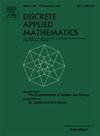Combinatorial and asymptotic results on the neighborhood grid
IF 1
3区 数学
Q3 MATHEMATICS, APPLIED
引用次数: 0
Abstract
In various application fields, such as fluid-, cell-, or crowd-simulations, spatial data structures are very important. They answer nearest neighbor queries which are instrumental in performing necessary computations for, e.g., taking the next time step in the simulation. Correspondingly, various such data structures have been developed, one being the neighborhood grid.
In this paper, we consider combinatorial aspects of this data structure. Particularly, we show that an assumption on uniqueness, made in previous works, is not actually satisfied. We extend the notions of the neighborhood grid to arbitrary grid sizes and dimensions and provide two alternative, correct versions of the proof that was broken by the dissatisfied assumption.
Furthermore, we explore both the uniqueness of certain states of the data structure as well as when the number of these states is maximized. We provide a partial classification by using the hook-length formula for rectangular Young tableaux. Finally, we conjecture how to extend this to all 2-dimensional cases.
邻域网格上的组合与渐近结果
在各种应用领域,如流体模拟、细胞模拟或人群模拟中,空间数据结构非常重要。它们回答最近邻查询,这有助于执行必要的计算,例如,在模拟中采取下一个时间步骤。相应地,各种这样的数据结构已经被开发出来,其中一种是邻域网格。在本文中,我们考虑这种数据结构的组合方面。特别是,我们表明,在以前的作品中所做的唯一性假设实际上并不满足。我们将邻域网格的概念扩展到任意网格大小和维度,并提供了被不满意假设打破的证明的两个可选的正确版本。此外,我们还探讨了数据结构的某些状态的唯一性以及这些状态的数量最大化时的唯一性。我们提供了一个部分分类使用钩长度公式的矩形杨氏表。最后,我们推测如何将其推广到所有二维情况。
本文章由计算机程序翻译,如有差异,请以英文原文为准。
求助全文
约1分钟内获得全文
求助全文
来源期刊

Discrete Applied Mathematics
数学-应用数学
CiteScore
2.30
自引率
9.10%
发文量
422
审稿时长
4.5 months
期刊介绍:
The aim of Discrete Applied Mathematics is to bring together research papers in different areas of algorithmic and applicable discrete mathematics as well as applications of combinatorial mathematics to informatics and various areas of science and technology. Contributions presented to the journal can be research papers, short notes, surveys, and possibly research problems. The "Communications" section will be devoted to the fastest possible publication of recent research results that are checked and recommended for publication by a member of the Editorial Board. The journal will also publish a limited number of book announcements as well as proceedings of conferences. These proceedings will be fully refereed and adhere to the normal standards of the journal.
Potential authors are advised to view the journal and the open calls-for-papers of special issues before submitting their manuscripts. Only high-quality, original work that is within the scope of the journal or the targeted special issue will be considered.
 求助内容:
求助内容: 应助结果提醒方式:
应助结果提醒方式:


